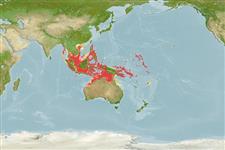Common names from other countries
>
Eupercaria/misc (Various families in series Eupercaria) >
Lutjanidae (Snappers) > Lutjaninae
Etymology: Lutjanus: Malay, ikan lutjan, name of a fish.
More on authors: Quoy & Gaimard.
Environment: milieu / climate zone / depth range / distribution range
Écologie
marin récifal; profondeur 20 - 150 m (Ref. 90102). Tropical; 21°N - 20°S, 92°E - 177°W (Ref. 55)
Western Pacific: Iriomote Island, Okinawa Prefecture, Japan; Fiji to Malay Peninsula. Also recorded from the Andaman Sea off Thailand. This species has been frequently confused with other red snappers, particularly Lutjanus malabaricus.
Taille / Poids / Âge
Maturity: Lm ? range ? - ? cm
Max length : 73.7 cm FL mâle / non sexé; (Ref. 125599); common length : 30.0 cm TL mâle / non sexé; (Ref. 55); poids max. publié: 6.7 kg (Ref. 125599)
Épines dorsales (Total): 11; Rayons mous dorsaux (Total): 14-15; Épines anales 3; Rayons mous anaux: 8. Dorsal profile of head steeply sloped. Preorbital width greater than eye diameter. Preopercular notch and knob poorly developed. Scale rows on back rising obliquely above lateral line. Axil of pectoral fin black. Young with a blackish or brownish band from upper jaw to the beginning of dorsal fin and a black saddle preceded by a pearly-white border on upper edge of caudal peduncle; horizontal stripes on sides (Ref. 469). Body depth 2.2-2.4 in SL (Ref. 90102).
Adults inhabit coral and rubble reefs. Usually solitary. Juveniles on muddy coastal slopes on open substrates with small outcrops of reef debris, usually in depth of 15 m or more (Ref. 48635). Relatively uncommon (Ref. 9710).
Life cycle and mating behavior
Maturité | Reproduction | Frai | Œufs | Fécondité | Larves
Allen, G.R., 1985. FAO Species Catalogue. Vol. 6. Snappers of the world. An annotated and illustrated catalogue of lutjanid species known to date. FAO Fish. Synop. 125(6):208 p. Rome: FAO. (Ref. 55)
Statut dans la liste rouge de l'IUCN (Ref. 130435)
CITES (Ref. 128078)
Not Evaluated
Menace pour l'homme
Harmless
Utilisations par l'homme
Pêcheries: intérêt commercial mineur
Plus d'informations
Noms communsSynonymesMétabolismePrédateursÉcotoxicologieReproductionMaturitéFraiFéconditéŒufsDéveloppement de l'œuf
RéférencesAquacultureProfil d'aquacultureSouchesGénétiqueElectrophoresesHéritabilitéPathologiesTraitementMass conversion
CollaborateursImagesStamps, Coins Misc.SonsCiguateraVitesseType de nageSurface branchialeOtolithesCerveauxVision
Outils
Articles particuliers
Télécharger en XML
Sources Internet
Estimates based on models
Preferred temperature (Ref.
115969): 23.9 - 28.4, mean 27.3 (based on 578 cells).
Phylogenetic diversity index (Ref.
82804): PD
50 = 0.5000 [Uniqueness, from 0.5 = low to 2.0 = high].
Bayesian length-weight: a=0.01413 (0.00864 - 0.02310), b=3.04 (2.91 - 3.17), in cm Total Length, based on LWR estimates for this species & Genus-body shape (Ref.
93245).
Niveau trophique (Ref.
69278): 4.0 ±0.66 se; based on food items.
Résilience (Ref.
120179): Faible, temps minimum de doublement de population : 4,5 à 14 années (Preliminary K or Fecundity.).
Fishing Vulnerability (Ref.
59153): Moderate vulnerability (39 of 100).
